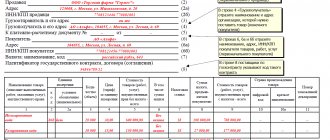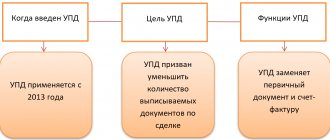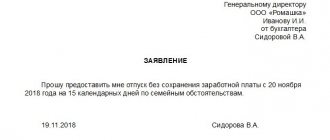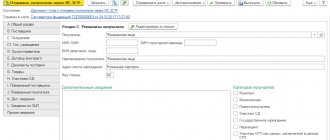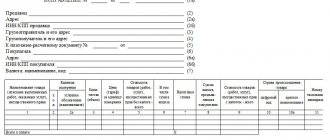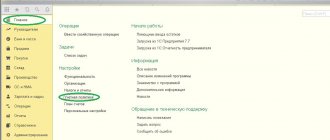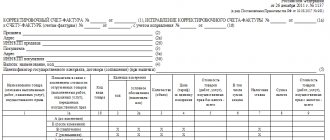As it was before
In the recent past, officials had a unequivocal opinion - it is prohibited to divide the VAT deduction for one invoice into different periods. Such conclusions can be found, for example, in letters of the Ministry of Finance dated December 9, 2010 No. 03-07-11/483, dated October 13, 2010 No. 03-07-11/408 and others. At the same time, the department’s specialists referred to the fact that such a procedure is not provided for by tax legislation. Indeed, Articles 171 and 172 of the Tax Code, devoted to deductions, did not contain rules directly allowing for the “scattering” of VAT deductions.
However, the majority of arbitration courts reasoned differently: firstly, the legislation does not directly prohibit deductions for partial applications, and, secondly, this does not lead to non-payment of tax. Therefore, the arbitrators in most cases recognized the splitting of the VAT deduction as legal. Similar conclusions are given, for example, in the Resolution of the Federal Antimonopoly Service of the Moscow Region dated February 12, 2013 No. F05-15985/12, as well as in many others.
What changed
This contradiction between the positions of the Ministry of Finance and the courts persisted until January 1, 2015. But to the delight of taxpayers, the situation has changed - on the specified date, amendments to the Tax Code came into force. One of them concerned Article 172, which was supplemented by paragraph 1.1 . According to the norm contained therein, it is now possible to claim VAT deductions in any tax period within three years from the date of acceptance of goods for accounting . This gives companies the opportunity to manage the amount of deductions and claim them in the period when they consider it necessary.
In what cases is this convenient? For example, if the taxpayer wants to avoid indicating the amount of VAT to be refunded in the declaration. After all, in doing so, he may be faced with a full-fledged desk audit, within the framework of which the tax service has the right to demand all documents to justify the deduction. And many accountants, in order to avoid this, will prefer to declare the deduction partially, transferring the rest of it to later periods.
New position of the financial department
The Tax Code still does not contain a direct rule allowing the deduction to be applied in parts - it only clearly allows it to be declared in tax periods within three years after the goods are accepted for accounting. However, now that flexible options for managing the deduction have appeared, the ban on its fragmentation loses all meaning . The position of Ministry of Finance officials has changed, which is reflected in letters No. 03-07-11/20290 and No. 03-07-11/20293 dated April 9, 2015. They conclude that splitting the VAT deduction for one invoice into several tax periods generally does not contradict the Tax Code.
The exception is transactions for the acquisition of fixed assets, equipment for installation and intangible assets - on the basis of paragraph 1 of Article 172 of the Tax Code of the Russian Federation, VAT on them is deducted in full after the said assets are accepted for accounting. In addition, splitting the deduction into several periods is unacceptable for VAT paid as a tax agent, as well as calculated from payment, prepayment and certain other transactions.
How can I get a VAT refund faster?
As shown above, returning VAT from the budget is a very lengthy process. Even with the most favorable option, it takes almost 2.5 months.
Of course, it is very unprofitable for businessmen to “freeze” their funds for several months. However, there is an option that can significantly (several times) reduce this period. This is the so-called “declarative” procedure for compensation, provided for in Art. 176.1 Tax Code of the Russian Federation.
In this case, the money can be received within 15 days after submitting the declaration. The law allocates 5 days for each stage (submission of an application, consideration of it by the Federal Tax Service and transfer of funds by the Treasury).
The following can count on an accelerated VAT refund:
- The largest taxpayers with tax payments exceeding 2 billion rubles. in 3 years.
- Those who provided a surety or bank guarantee. Moreover, the guarantor must be the largest taxpayer, and the guarantor bank must comply with the requirements of Art. 74.1 of the Tax Code of the Russian Federation on the amount of capital and other basic parameters.
- Residents of territories of rapid economic development. They can receive this benefit if they provide a guarantee to a management company authorized by the Government of the Russian Federation.
Expedited VAT refund does not cancel the desk audit of the declaration, which is carried out “on a general basis.” If it is revealed that the amount of tax (or part of it) was reimbursed unreasonably, the businessman will have to return the money to the budget and pay penalties based on the double refinancing rate of the Central Bank of the Russian Federation (Clause 17, Article 176.1 of the Tax Code of the Russian Federation).
What does this look like in practice?
What is the procedure for an accountant if it is necessary to declare a VAT deduction in parts in different periods? Let's look at an example.
In the second quarter of 2015, Ajax LLC purchased a passenger car from Avtotrade LLC at a price of 944,000 rubles, including VAT of 144,000 rubles. The purpose of buying a car is further resale. The buyer's accountant decided to claim VAT deduction in equal installments until the end of the current year. Thus, a deduction in the amount of 48,000 rubles (1/3 of 144,000) will be declared in the II, III and IV quarters of 2015.
At the time of purchase, that is, in the second quarter of 2015, the following transactions are made:
| Wiring | Amount (RUB) | Operation description |
| Dt 08 Kt 60 | 800000 | car price excluding VAT |
| Dt 19 Kt 60 | 144000 | VAT amount |
| Dt 68 Kt 19 | 48000 | first part of VAT deduction |
In the same period, an invoice from Autotrade LLC in the amount of 48,000 rubles is registered in the Purchase Book of Ajax LLC.
In the following quarters of 2015, the accountant must repeat the last entry:
| Quarter 2015 | Wiring | Amount (RUB) | Operation description |
| III | Dt 68 Kt 19 | 48000 | second part of the VAT deduction |
| IV | Dt 68 Kt 19 | 48000 | third part of VAT deduction |
In each of these periods, you should also register an invoice from Autotrade LLC in the amount of 48,000 rubles. Thus, the invoice will appear in the Purchase Book not once indicating the full amount of VAT of 144,000 rubles, but three times for 48,000 rubles.
You can enter the second and third parts of the tax into the Purchase Book on any day of the corresponding period. For example, it is quite convenient to do this on the first day of the quarter.
By the same principle, the accountant of Ajax LLC could “split” the VAT deduction not into equal parts, but into arbitrary parts and into any number of periods within a three-year period from the moment the car was registered. Accepting the deduction in parts with “jumping” over one or more quarters also does not contradict the Tax Code. For example, if for some reason Ajax LLC had no sales operations in the fourth quarter of 2015, then it would be logical for the accountant to transfer the last part of the deduction to the first or any other quarter of 2016.
So, let’s summarize the main points of splitting the VAT deduction:
- You can claim part of the deduction in any quarter, the main thing is that the entire amount is “spent” within three years from the moment the goods are registered;
- the declared part of the deduction must correspond to an entry in the Purchase Book made in the same quarter and for the same amount;
- one invoice will be recorded in the Purchase Book several times in different quarters for an amount corresponding to the declared part of the deduction;
- when adding the partial deduction amounts, the VAT amount indicated on the invoice should be obtained.
VAT refund deadlines
With the “standard” VAT refund scheme, the following options are possible:
- If there are no signs of violations, the desk inspection lasts up to 2 months (Clause 2 of Article 88 of the Tax Code of the Russian Federation). Next, the tax authorities are given 7 days to make a decision and send it to the treasury. Funds will be transferred within 5 days. Therefore, with the “problem-free” option, 2 months and 12 days will pass from submitting the declaration to receiving the funds. Of course, theoretically, a desk audit could be completed faster, but usually officials drag it out until the last day.
- If inspectors have suspicions during the inspection, then its period can be extended to 3 months. Consequently, the total reimbursement period is extended to 3 months and 12 days.
- If suspicions are confirmed and violations are identified, then two options are possible:
A. Violations “cover” the entire tax refund. In this case, the return is canceled and there is no point in talking about deadlines.
B. Based on the results of the inspection, compensation was only partially denied. Then the time frame for returning from the budget will also depend on the provisions of Art. 100 and 101 of the Tax Code of the Russian Federation. An inspection if there are violations can last up to 3 months. Next 10 days are given to the tax authorities to draw up the report. The report must be sent to the taxpayer within 5 days. After this, the businessman can submit objections to the act within a month. After another 10 days, a decision is made, and 5 days after that, the treasury transfers the money.
As a result, the period for tax refund is delayed to 5 months.
(3 months + 10 days + 5 days + 1 month + 10 days + 5 days)
It should be noted that even if there is a decision to refund VAT, the funds will not be returned to the taxpayer “automatically”. You still need to write a corresponding statement, and it must be received by the tax authorities before making a decision. Otherwise, you will have to wait another month for a refund (clause 11.1 of Article 176 and Article 78 of the Tax Code of the Russian Federation).
If the established deadlines are violated, the businessman has the right to receive not only the amount of the refunded tax, but also interest for the delay, calculated from the refinancing rate of the Central Bank of the Russian Federation (clause 10 of Article 176 of the Tax Code of the Russian Federation).
Deduction of VAT in parts and reconciliation of the Federal Tax Service
As you know, since the beginning of this year, the tax service has been carefully monitoring all VAT payers, processing their electronic reports automatically. At the same time, information from the books of purchases and sales of counterparties is compared, which have now become part of the expanded tax return. For each transaction, the data specified by the seller and the buyer are compared, including the amount of VAT.
However, if the buyer decides to “split” the deduction into several periods, then VAT will be partially reflected in his Purchase Book, which will not correspond to the entry in the supplier’s Sales Book. When conducting a cross-reconciliation at the end of the quarter, the tax office will identify this discrepancy and may require an explanation. Moreover, based on clause 8.1 of Article 88 of the Tax Code of the Russian Federation, the inspectorate will be able to demand the presentation of an invoice and other documents regarding the transaction, because formally the amount of tax in the buyer’s declaration will be underestimated. As a result, some accountants still prefer not to split deductions due to reluctance to communicate with the Federal Tax Service or fear of sanctions.
But according to many experts, it is completely safe to deduct VAT in parts. Of course, there is a risk of receiving a request from the inspectorate to provide explanations. But since by declaring a partial deduction, the buyer does not violate tax laws, he will be able to explain his actions, submit the necessary documents and without any problems “justify” the incomplete amount of VAT.
VAT refund procedure
The general regulations for VAT refunds are given in Art. 176 of the Tax Code of the Russian Federation.
Before you begin the VAT refund procedure, you need to understand that you generally have the right to do so. This is determined when filling out the declaration. But even if, based on the results of the calculations, it turns out that the budget owes you, do not rush to submit the report to the tax office.
Any declaration received by the Federal Tax Service undergoes a desk audit. But if it provides for a tax refund, the attention of inspectors increases many times over.
Therefore, it is necessary to carefully check all supporting documents, first of all, “incoming” invoices. You need to be prepared for the fact that tax authorities will check each of your suppliers and customers using the automated system “ASK VAT-2”. Therefore, all counterparties included in the declaration must be “white”, i.e. actually conduct business, submit reports and pay taxes.
Also, tax officials, as part of a desk audit, can send additional requests and even go “on site” to inspect the taxpayer’s premises. It is also possible that the company's management will be called to the Federal Tax Service for a commission.
All these measures are aimed at making the VAT refund procedure as difficult as possible for a businessman. Therefore, to receive tax from the budget, correctly executed documents alone are not enough. Perseverance and strong nerves are also required.
But if all the problems have been resolved, the refund stage begins. We will tell you in what time frame you can expect to receive money in the next section.
You also need to remember that before returning, inspectors will automatically conduct an assessment. They will “cover” through overpayment the previously formed arrears not only for VAT, but also for other federal taxes, as well as fines and penalties.
In addition, the taxpayer can voluntarily offset the refundable amount against future payments (clause 6 of Article 176 of the Tax Code of the Russian Federation).
